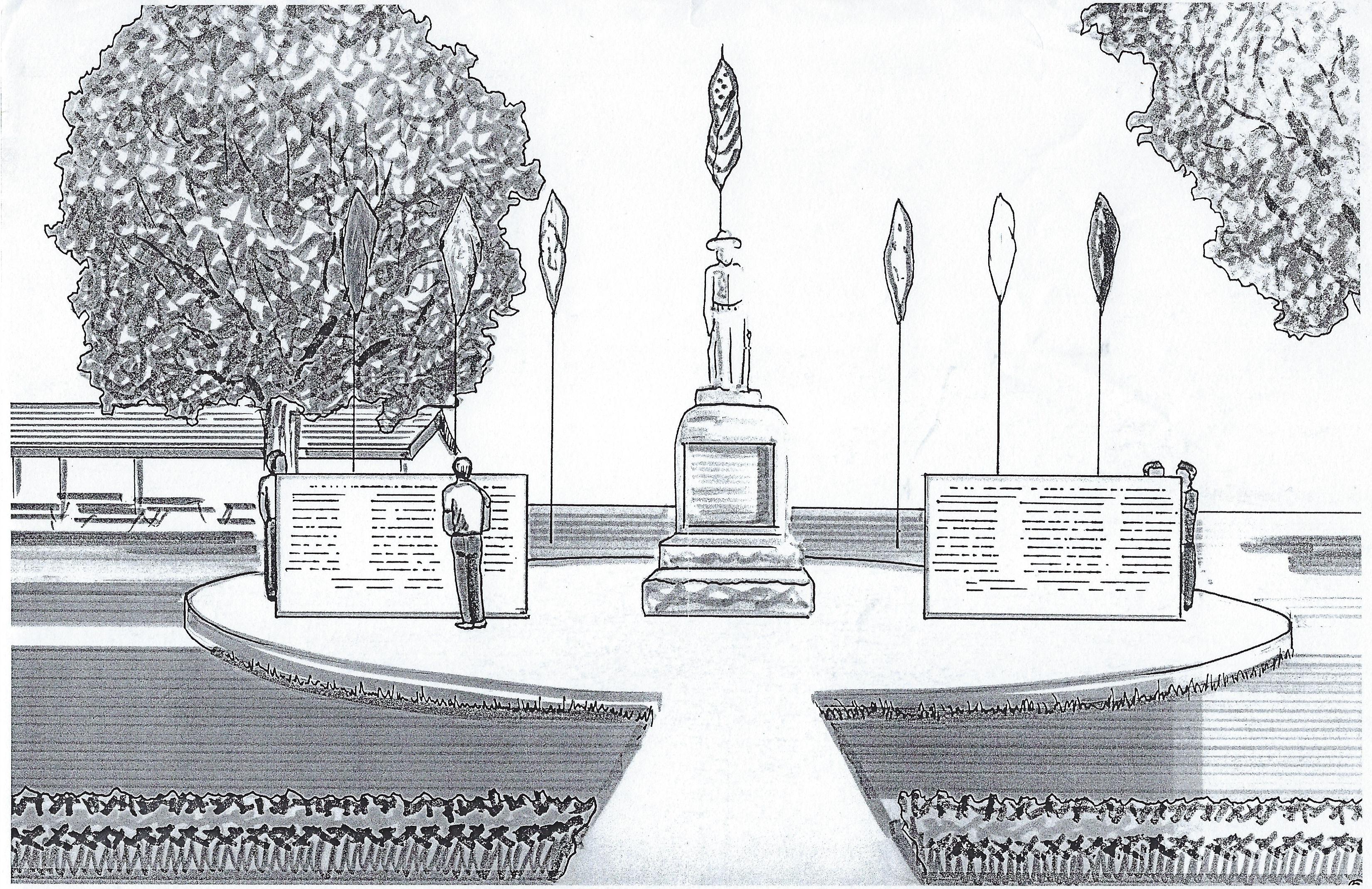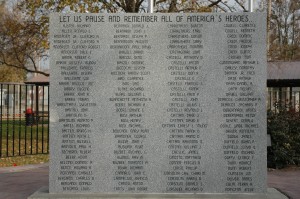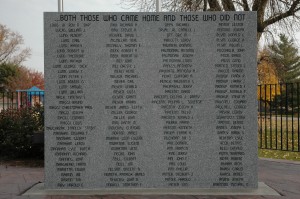VETERAN’S MEMORIAL MONUMENTS
Former Village President Mike Grivetti’s dream of a memorial honoring Ladd’s post-WWI veterans began with an organizational meeting for interested citizens in January 2006. Mike presented his idea of a monument placed in Ladd’s War Memorial Park recognizing our servicemen and servicewomen. Illuminated poles with flags from the Army, Navy, Air Force, Marines and Coast Guard along with an American flag would sit directly behind the monument. It was decided that anyone who was a serviceman or servicewoman for 6 months and was honorably discharged was eligible for inclusion on the memorial. At one time they must have been a resident of the Ladd Grade School District, but not necessarily during their enlisted years. With the guidelines in place, an account was established at North Central Bank for donations. A month later, a second meeting was held with representatives from Moore Monument Company in attendance to present sketches of monuments. The citizens in attendance agreed on a proposal of $11,116.00 for two 6’x8’x5′ grey granite slabs with the names to be inscribed on both sides. (Chosen design is shown below). The slabs would sit level on either side of the existing WWI monument. In the meantime, the submission of veteran’s names and monetary donations had begun to come in.
Seventeen months later, the Veteran’s Memorial Monument was dedicated during the 2007 Memorial Day services. A large crowd was in attendance to hear Mayor Grivetti speak the following words:
“A d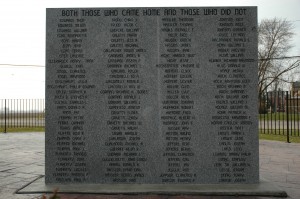 ream
ream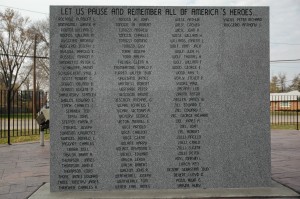 comes true. On behalf of the Village Council, the employees, and myself, I want to welcome everyone to the Memorial Day Services 2007. Yes, this is the day a dream came true for me. When I got out of the Armed Services in the late ’50s, I was still very much a military man. I told myself that if I ever got in the right position, I would help put up a monument honoring all the military men and women from Ladd that served their country after World War I. And after I was elected Mayor of this wonderful town in 2005, I decided to get things moving. Thanks to many, many generous people, it has become a reality. After many town meetings, a plan was set. It was decided that anyone that ever lived in the Ladd School District and served in the military would be eligible to have their names put on a wall of honor.
comes true. On behalf of the Village Council, the employees, and myself, I want to welcome everyone to the Memorial Day Services 2007. Yes, this is the day a dream came true for me. When I got out of the Armed Services in the late ’50s, I was still very much a military man. I told myself that if I ever got in the right position, I would help put up a monument honoring all the military men and women from Ladd that served their country after World War I. And after I was elected Mayor of this wonderful town in 2005, I decided to get things moving. Thanks to many, many generous people, it has become a reality. After many town meetings, a plan was set. It was decided that anyone that ever lived in the Ladd School District and served in the military would be eligible to have their names put on a wall of honor.
Thanks to the Village Council for all of their support and to the Village workers for all of their effort in helping with the construction. A special thanks to Diane Chandler for her hours of collecting money and arranging of all the names for the monument. She did a great job. I’d also like to thank Gary Marini and all the hard-working members of the CIA for their hard work in raising funds and then giving a large portion to this project. At this time, I would like to thank the following businesses for their help in the construction of the project. EJ Cattani & Son for their monetary help and also for their help in the setting of the monuments. To Wilson Landscaping for their donation of all the labor to erect the walls and for their time and material in shaping and seeding of the grounds. To Jason Pottinger for his donation of labor in stamping the concrete. To Springfield Electric for their donation of the lighting system. To the owners of Princeton Redi-Mix, Jim & Gwen Walsh, and Jim & Joan Perona for their donation of all the concrete for the entire project. To the Hurst Funeral Home for their donation of all the flags and poles for the project. To Valley Fabrication, Inc. for donating their labor and installing the railing. Also, last but not least, I would like to thank everyone who gave money to help pay for this project. We could not have gotten this started without you. No matter if you gave $5, $500 or $5,000, you are all a part of this project and you should be very proud of it. If you have not donated to the project and would like to, we still need money to help pay for the “Man in the Middle.” You can make checks payable to “Ladd Veteran’s Memorial” at the Village Clerk’s office.
At this time, I would like to recognize two men who have been a part of this community for a long time. The first veteran was on the USS West Virginia on December 7, 1941, when his ship was attacked in Pearl Harbor. He survived that day and came home to be a part of Ladd in many ways. At the age of 92, he is still in the Color Guard of the American Legion and one of the few living veterans of the attack on Pearl Harbor. Mr. Henry (Hank) Ellerbrock, we are proud of you. The next is a man who was wounded in action in Italy on March 1, 1944 and received the Purple Heart. In 1965, he was elected mayor and served our town for 32 great years, Mr. Harry Volant. Harry, great job.
And now, I am proud to dedicate this memorial to the 476 men and women who served their country and who would have done anything in their power to help preserve our life, liberty and pursuit of happiness. Thank you. And now, I would like to introduce our guest speaker, the man who is responsible for getting us a grant of $35,000 to restore our statue. We are most grateful to our representative of the 76th Legislative District, Mr. Frank Mautino.”
The Veteran’s Memorial Monument is a beautiful tribute to Ladd’s servicemen and servicewomen. Thank you, Mayor Grivetti, for following your dream.
We invite you to Ladd to visit our Veteran’s Memorial Monument and our restored World War I Memorial Monument. Both are located in Ladd’s War Memorial Park on South Main Avenue (Illinois Route 89).
WWI MONUMENT RESTORATION
In March of 1919, the Ladd War Relief Association decided to build a monument to be dedicated to the boys who had risked or sacrificed their lives for the good of their country. In June, the contract was given to the Mendota Monument Company to erect the memorial, taking three months to complete. It was dedicated before a large crowd on October 4, 1919, in Ladd Memorial Park, the site donated by the village for that purpose. The memorial is of gray monumental stone and its base is what is known as pitched rock work. The statue, known as the American Soldier, was hewn from Bedford monumental statuary stone. The figure of the United States soldier which surmounts the monument is six feet, six inches high and weighs 2200 pounds. On three sides of the rock worked base are bronze tablets with the names of 117 servicemen, one bronze tablet with the names of Ladd’s heroic dead, the other two with the names of all the soldiers and sailors of Ladd. Those who paid the supreme sacrifice are indicated thereon with a star before their names. The monument stands fourteen feet high, is six feet square at the base and weighs 27,400 pounds. The foundation is of solid concrete which is seven feet deep. A five feet circular sidewalk surrounds the base of the statue and it extends to the street from the monument. It is reported that this monument was one of the first of its kind in the state of Illinois.
Through the years, time and weather have taken their toll on the American Soldier. In 2006, plans were considered to restore the statue to its original glory. Through the efforts of the Ladd Community Improvement Association, the Village of Ladd, North Central Illinois Council of Governments, and Illinois State Representative Frank Mautino, restoration grant money was secured. A fund-raising effort, “Save Our Soldier” began with numerous monetary donations received, many as memorials to deceased family members. In the summer of 2007, work was begun on the restoration by Andrzej Dajnowski of Conservation of Sculpture and Objects Studio, Inc. The following is a detailed account of his restoration efforts.
The sculpture was in a very deteriorated and aesthetically unpleasant condition. The 3 bronze plaques on the base of the monument were corroded, the limestone base was stained green from the leeching of these corrosion products, and many detail elements were entirely missing from the composition. Conservation of Sculpture and Objects Studio, Inc. (CSOS) erected a two-level scaffold to treat the monument.

The soldier’s face was entirely missing and resulted in a very disturbing appearance of the figure. Only minute traces of what appeared to be: nostrils, lips, nose, and mustache were visible.
New damage was found at the top of the proper right shoulder. It appeared that a rock was thrown at the sculpture and a piece (2 1/2 inches in diameter) was missing at the time when we started our treatment.
The figure was also missing several other elements:
- 90% of his proper right ear.
- 70% of his proper left ear.
- Approximately 45% of the soldiers’ hat.
- The trigger and strap section on the rifle.
- A section of one of the pouches on the soldiers’ belt was missing.
- The soldiers’ pinkie finger and sections of the rest of the fingers on his proper right hand.
The entire monument was carefully steam cleaned several times to remove all dirt and debris from the surface. Next, we applied a ProSoCo product called Biowash. This product was left on the surface from half an hour to an hour and the surface was steam washed again. Most of the dirt and black staining were removed in this process. At this time we tested the laser ablation process to remove a few black spots still remaining on the surface of the sculpture. Unfortunately, this process was unsuccessful and a decision was made to use a poultice technique to eliminate this problem. A poultice composed of cellulose (paper pulp) was mixed with a 5% solution of Acidic acid and distilled water. The poultice was applied to the remaining black areas. The black spots were located in crevices and undercut parts of the sculpture. The poultice was left on the surface from one to 12 hours and the surface was steam washed again. After a few days of treatment, the black stains were removed.
The bronze plaques were cleaned of loose corrosion using bronze wool and steam. One request of the owner CSOS removed the extra “M” from the plaque on the North side of the base to correct the name “George Plymm” and make it “Plym”, as was requested. The “M” was removed using a small chisel. The area was chased to match the appearance of the rest of the plaque.
The missing rosettes were copied using original rosettes that were temporarily removed from the plaques. New rosettes were cast in bronze in a sand casting technique. The new rosettes were attached to the plaques. One of the ferrous screws that was holding a rosette was replaced with a bronze threaded rod of the same size. The bronze plaques were given a new patina and hot coated with microcrystalline protective wax. The plaques were buffed with cotton cloth as the last step of their treatment.
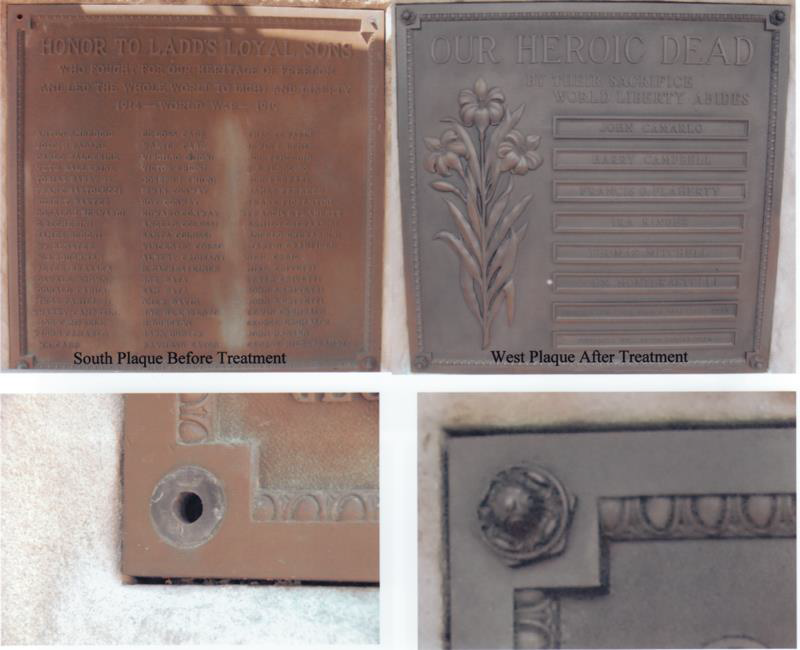
The surfaces of the areas with missing elements were first consolidated with ProSoCo “HIOO Consolidation Treatment”. The consolidant was left on the surface and allowed to cure for a few days. Then, a German product called Jahn was used to reconstruct the missing details. Tiny holes were strategically drilled into the areas missing elements to which a titanium frame was secured. The Jahn was sculpted onto these titanium supports. The newly sculpted areas were repeatedly sprayed with mist for several days to ensure they cured slowly and properly despite the extreme 90-degree weather conditions.
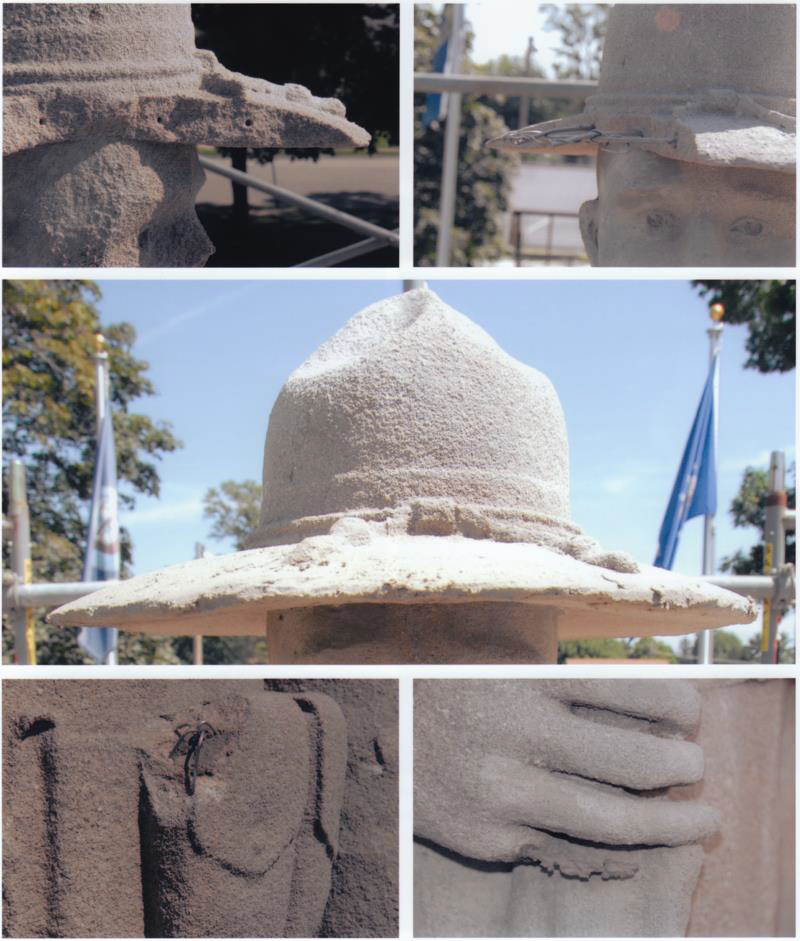
The pinkie finger was sculpted with reference to a living model and the missing trigger elements were replicated based on an examination of WWI rifles.
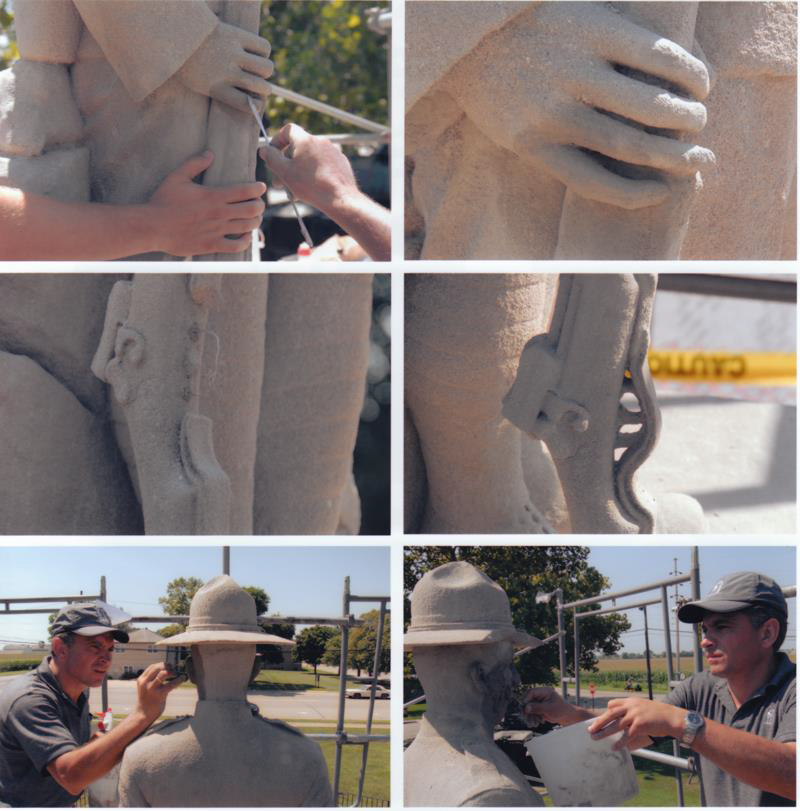
Andrzej Dajnowski patiently sculpted all of the missing elements of the soldier with pigmented Jahn that matches the original color of the stone.
The face of the soldier was sculpted on the basis of small remaining fragments that gave clues as to the original structure. There were small remnants of a mustache still barely visible as well as segments that indicated the size of the original nose. We were provided with a small picture of the monument that did not show much detail, but it did show shadows of the facial features which aided in assessing the proper proportions. Similar monuments of soldiers from that period were analyzed. Historical pictures of American soldiers with mustaches from WWI were also examined.
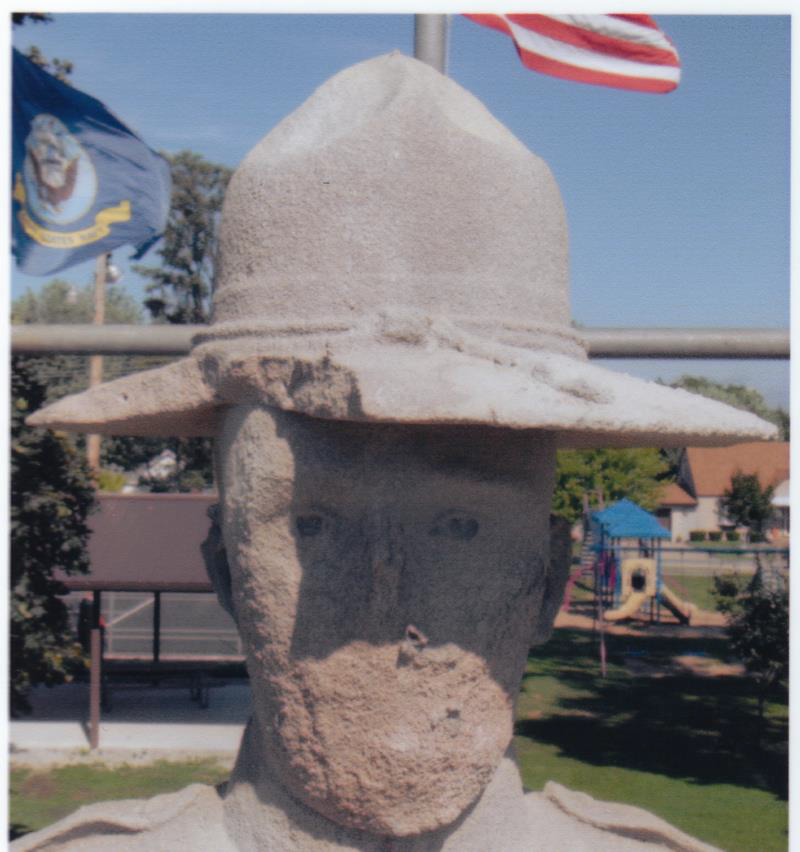
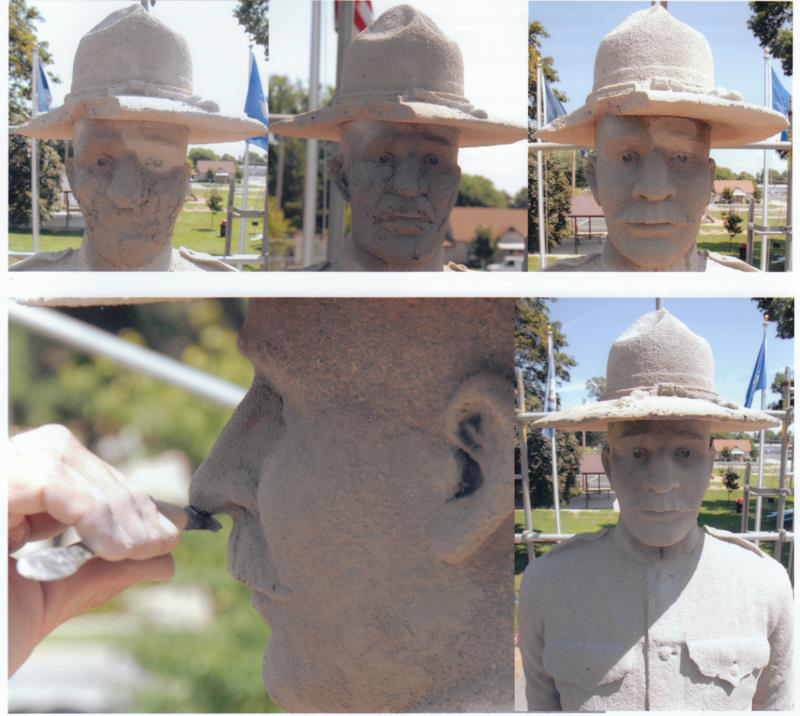
Laser cleaning was tested on very small hidden areas of the stone and proved to be ineffective because of the porous and soft nature of the limestone which burned during exposure to the laser beam. It was decided that chemical poultices would be used to extract the stains from the stone.
A poultice composed of cellulose compound (paper pulp) and 5% ammonia bicarbonate was applied to the stained (copper – green) areas and allowed to sit for first a few hours. After a few days of testing the poultices were left on the surface for 12 to 15 hours until it dried and extracted the stains from the stone. Next, the treated area was covered with a second poultice composed of cellulose and pure distilled water. The purpose of the second poultice was to extract any remaining ammonia bicarbonate from the surface of the stone to purify the surface. The purifying poultice was removed and the stone was then washed and allowed to dry.
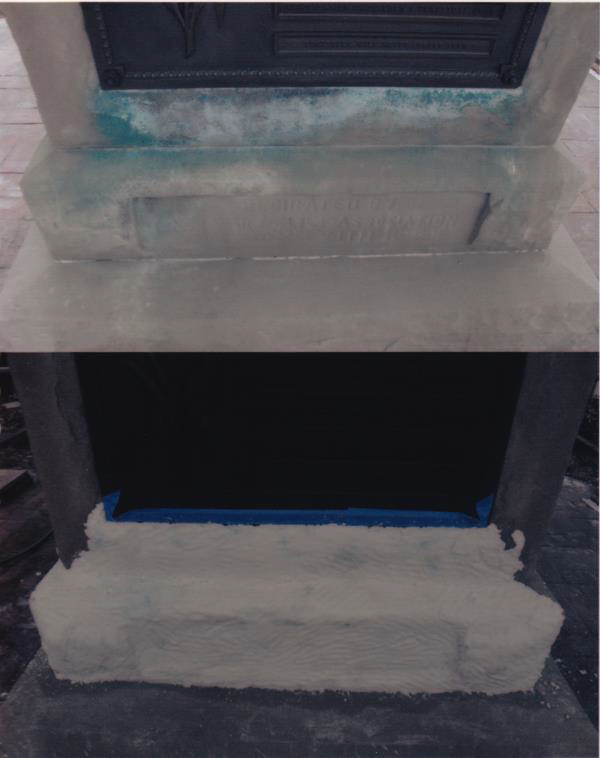
This poultice system was also applied to the sleeves and crotch area of the soldier for an hour to remove yellowish discoloration found there. The stains within the stone base were very deep and continued to resurface after each treatment. Weather conditions such as high humidity and repeated rain slowed the process down. Special tents were erected on the scaffold several times to protect the poultices from being diluted and torn down by rain. This two-step poultice process was repeated continuously for three weeks until the stains subsided. Final stain removal was executed by rinsing with ProSoCo Bio-Klean.
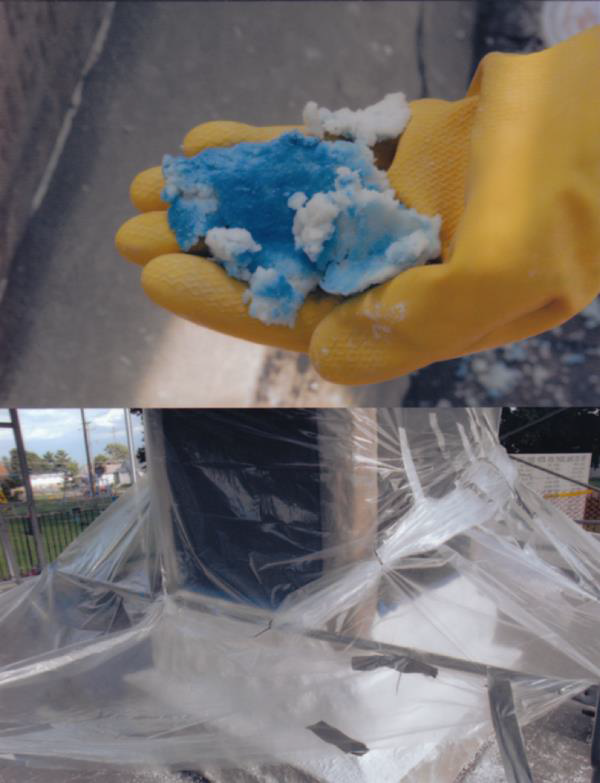
Sand and Attagel-clay were added to the final 4 poultice applications to enhance the extraction properties. The surface of the sculpture was washed. The new pavement surrounding the statue was thoroughly rinsed after every poultice treatment to remove any chemicals from the area.
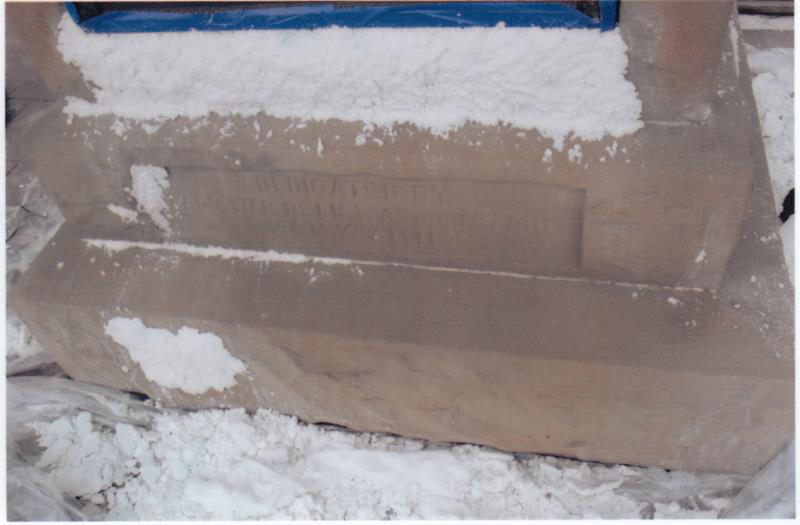
The major cracks in the base of the limestone were injected with white Jahn M-30 injection grout to prevent water from entering and causing potential freeze and thaw damage in the winter. A layer of grey pigmented Jahn M-30 was immediately applied over the white M-30 to blend in with the stone. The joint between the two blocks of the limestone base was pointed with lime-based mortar.
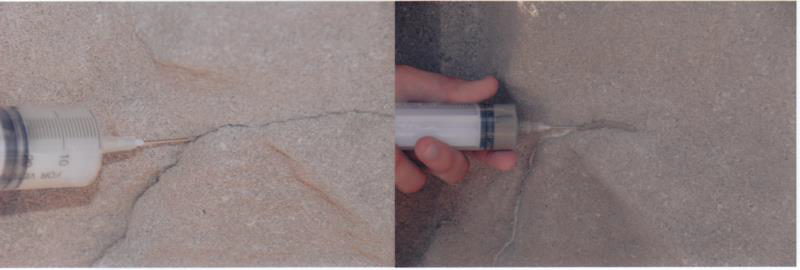
We noticed a very large amount of dead ladybugs coming out of the bottom left corner of the plaque on the North side of the base. Every time this corner was flushed with water more ladybugs would come pouring out. Over one cup full of ladybugs was removed from this area, which indicated that there is space for them to nest behind the plaque and this may or may not lead to organic substances leaching from this area in the future if the nesting continues.
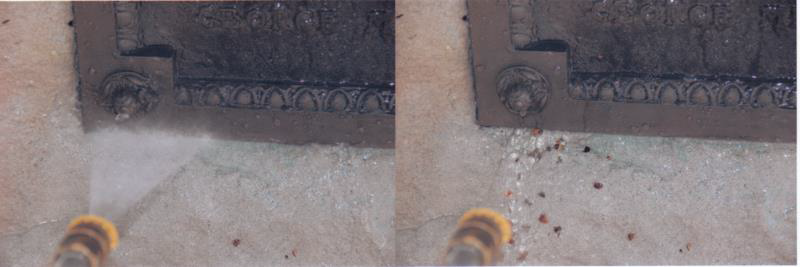
As the last step of the treatment, the sculpture and the base were coated with H-40 Masonry Strengthener and water repellent manufactured by ProSoCo. The base was also coated with “Graffiti Pruf” – an acrylic-based water emulsion that can be removed using only steam in case of vandalism. We have used this coating successfully for the last 15 years on many monuments.
The entire treatment was documented using digital photography.
CSOS Staff:
Andrzej Dajnowski – director – lead conservator
Gabriel Harrison – project manager – conservator
Rossana Ioppolo – conservator
Bartosz Dajnowski – project manager – assistant conservator
Materials and equipment used:
- Steamer
- 120 W Adapt laser
- Biowash – ProSoCo
- BioKlean – ProSoCo
- H-40 masonry strengthener and water repellent – ProSoCo
- H-100 stone strengthener – ProSoCo
- Graffiti Pruf – Visual Pollution Tech, Inc. (480-657-9183)
- Ammonium Bicarbonate – Fisher Scientific
- Distilled water – local stores such as Jewel
- Arbocel BC200 – paper pulp
- Attagel – clay
- Silica Sand
- Lime base mortar
- Jahn – Cathedral Stone. This material was custom made for this project. Before the work started we took a small sample of the stone from the base of the sculpture. The stone was mailed to Cathedral Stone, analyzed in their lab, and color and material were matched. Samples of the Jahn were also prepared on-site prior to our treatment to ensure the color-matched.
Submitted by
Andrzej Dajnowski, Director Conservation of Sculpture and Objects Studio Inc. (CSOS)
900 S. Des Plaines Ave.
Forest Park, IL 60130
Tel. # 773-594-1451
Fax # 773-594-0583
August 2007

